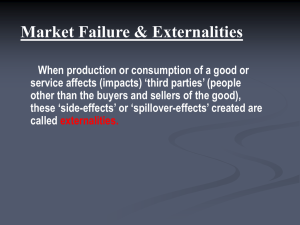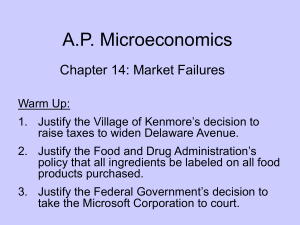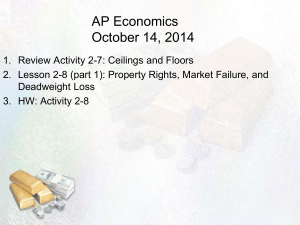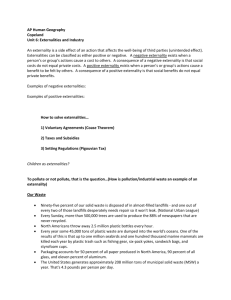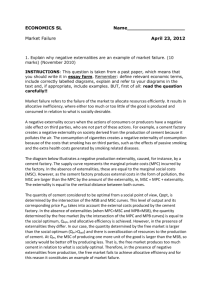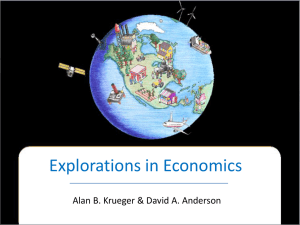Externalities, Market Failure, and Government Policy Production
advertisement
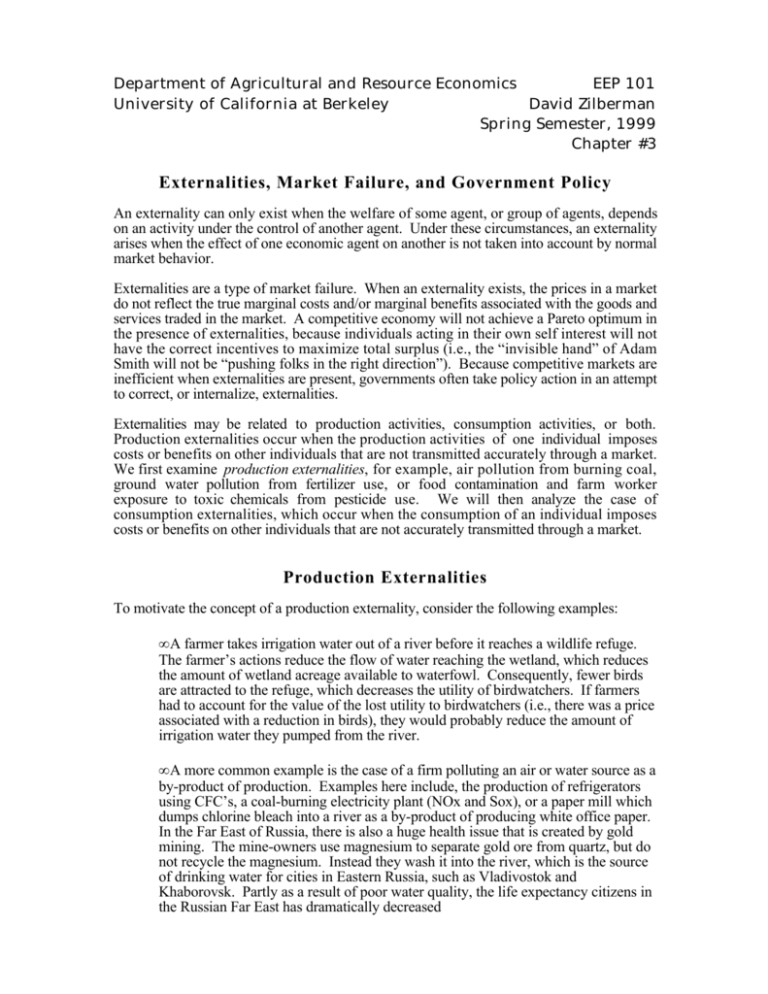
Department of Agricultural and Resource Economics
EEP 101
University of California at Berkeley
David Zilberman
Spring Semester, 1999
Chapter #3
Externalities, Market Failure, and Government Policy
An externality can only exist when the welfare of some agent, or group of agents, depends
on an activity under the control of another agent. Under these circumstances, an externality
arises when the effect of one economic agent on another is not taken into account by normal
market behavior.
Externalities are a type of market failure. When an externality exists, the prices in a market
do not reflect the true marginal costs and/or marginal benefits associated with the goods and
services traded in the market. A competitive economy will not achieve a Pareto optimum in
the presence of externalities, because individuals acting in their own self interest will not
have the correct incentives to maximize total surplus (i.e., the “invisible hand” of Adam
Smith will not be “pushing folks in the right direction”). Because competitive markets are
inefficient when externalities are present, governments often take policy action in an attempt
to correct, or internalize, externalities.
Externalities may be related to production activities, consumption activities, or both.
Production externalities occur when the production activities of one individual imposes
costs or benefits on other individuals that are not transmitted accurately through a market.
We first examine production externalities, for example, air pollution from burning coal,
ground water pollution from fertilizer use, or food contamination and farm worker
exposure to toxic chemicals from pesticide use. We will then analyze the case of
consumption externalities, which occur when the consumption of an individual imposes
costs or benefits on other individuals that are not accurately transmitted through a market.
Production Externalities
To motivate the concept of a production externality, consider the following examples:
• A farmer takes irrigation water out of a river before it reaches a wildlife refuge.
The farmer’s actions reduce the flow of water reaching the wetland, which reduces
the amount of wetland acreage available to waterfowl. Consequently, fewer birds
are attracted to the refuge, which decreases the utility of birdwatchers. If farmers
had to account for the value of the lost utility to birdwatchers (i.e., there was a price
associated with a reduction in birds), they would probably reduce the amount of
irrigation water they pumped from the river.
• A more common example is the case of a firm polluting an air or water source as a
by-product of production. Examples here include, the production of refrigerators
using CFC’s, a coal-burning electricity plant (NOx and Sox), or a paper mill which
dumps chlorine bleach into a river as a by-product of producing white office paper.
In the Far East of Russia, there is also a huge health issue that is created by gold
mining. The mine-owners use magnesium to separate gold ore from quartz, but do
not recycle the magnesium. Instead they wash it into the river, which is the source
of drinking water for cities in Eastern Russia, such as Vladivostok and
Khaborovsk. Partly as a result of poor water quality, the life expectancy citizens in
the Russian Far East has dramatically decreased
Production Externalities and the Failure of Competitive Markets
Figure 1.1
MPC = marginal private cost (this is the inverse of the private supply curve)
MEC = marginal externality cost (suffered by people damaged by pollution)
MSC = social cost (vertical sum of MPC and MEC)
Social optimum at B (where MSB=MSC)
Social Benefits = ABQ*O.
Social Costs = OBQ*.
Social Welfare = ABO.
Free market outcome at C
Social Benefits = ACQcO.
Social Costs = OCQc + OEC = OEQc.
Social Welfare = ABO - BEC.
Deadweight Loss = BEC.
An example of a case where pollution is directly related to output:
Fertilizers: Use of fertilizers leads to nitrate / phosphate contamination of ground
water. Thus, the output of fertilizer might be a good example to keep in mind.
-2-
A Mathematical Representation of Production Externalities
Definitions:
Q = Output
B(Q) = Total Social Benefit of Producing Q.
C(Q) = Total Private Cost of Producing Q.
E(Q) = Total External Cost of Producing Q.
W(Q) = Social Welfare Function (Total Surplus From Producing Q).
Deriving the Condition for a Social Optimum:
The Social Welfare Maximization Problem is:
Max.{W (Q) = B(Q) − C(Q) − E (Q)}.
Q
Social Welfare is maximized where Q satisfies the First-Order Condition (FOC):
WQ = BQ (Q) − CQ( Q) − EQ(Q) .
Where:
BQ(Q) = the partial derivative of B(Q) with respect to Q.
Note that BQ(Q) marginal benefit = MB
CQ(Q) = the partial derivative of C(Q) with respect to Q.
Note that CQ(Q) = marginal private cost = MPC
EQ(Q) = the partial derivative of C(Q) with respect to Q.
Note that EQ(Q) = marginal external cost = MEC
Solving the FOC for Q gives the socially optimal output, call it Q*.
Notice that we can rearrange the FOC as follows:
BQ(Q) = CQ(Q) + EQ(Q)
In this form, we see that the FOC implies that the social optimum, Q*, occurs when the
following rule holds:
MB = MPC + MEC.
How Does Unregulated Competition Perform in the Presence of
Externalities?
Under unregulated competition, firms maximize profits, resulting in the FOC:
BQ(Q) = CQ(Q),
which is the familiar rule: MB = MPC
When this FOC is solved for Q, call it QC, we find that QC ≠Q*. In fact, we find that
QC< Q* whenever MEC > 0. Because QC ≠Q*, QC cannot be the socially optimal Q.
Thus, QC is inefficient.
-3-
Because a competitive economy will be inefficient (will not achieve a Pareto Optimum) in
the presence of externalities, combating externalities is a legitimate arena for government
policy. The policy goal is to move the economy to a socially optimal point such as point B
in Figure 1.1, where MSB (i.e., Demand) equals MSC.
This social optimum may be achieved by any of several policies. We will examine three
policies:
(1) a Tax
(2) a Subsidy
(3) a Restriction, Standard, or Quota
We will find that the choice of policy has implications for the distribution of economic
benefits among producers, consumers and government.
Before we begin our analysis, we should briefly discuss the targeting of externality
control policies. Targeting refers to the process of deciding which economic variable (e.g.
output quantity or input price) should be regulated in an attempt to control the externality.
Each policy mentioned in the preceding paragraph can be targeted in several ways. Typical
targets include outputs, inputs, or the externality-generating activity itself (i.e., the
pollutant). In most cases, targeting the externality-generating activity itself, or its
associated price, is the most efficient approach, because targeting outputs or inputs (or their
prices) creates distortions in the relative prices of goods and thus generates other economic
inefficiencies (in a general equilibrium).
Policy 1: Externality Tax ("Pollution Tax") or Output Tax
Suppose the government establishes an Externality Tax of t* = P* - PP. It is easy to
show that a tax of t* is the required market correction to achieve Q* units of production.
This fact can be seen graphically in figure 1.1 when we realize that the firm treats the tax
rate as an additional component of its marginal private cost; that is, a unit tax of t* shifts
the MPC curve upwards in a parallel fashion by the distance t*. The optimal tax (i.e. the
one that achieves Q*) is clearly t* = MEC(Q*).
The welfare implications of the Externality Tax are:
Consumer surplus= ABP*
Producer surplus = OFPP
Government revenue= P*BFPP
If the government knows how much pollution is produced per unit of production output,
then the government can set a tax on production output that achieves the same results as an
externality tax. In practice, however, the relationship between pollution and production
output is often very difficult to estimate with any degree of precision.
Keep in mind that the government revenue from either type of tax not only corrects the
externality, it also gives the government the opportunity to reduce other, distortionary taxes
(such as income taxes or sales taxes) in the economy, thereby eliminating other deadweight
losses in the economy. Such spillover benefits from one market to another can be
computed in general equilibrium models.
-4-
A Mathematical Representation Continued:
We can easily show that the appropriate externality tax, t*, needed to bring unregulated
competition in line with the social optimum is:
t* = EQ(Q*) = MEC(Q*)
A unit tax of t* results in the following private optimization problem:
Max .{π (Q) = PQ − C( Q) − t * Q}
Q
which yield the FOC:
π Q(Q) = P − CQ (Q) − t * = 0
or, P = CQ(Q) + t*.
Since P = MB at all points along the demand curve, and since the regulator has set
t* = EQ(Q*), we can express the private condition under the tax as:
BQ(Q*) = CQ(Q*) + EQ(Q*)
which is identical to the condition for a social optimum.
An Alternative Presentation of Production Externalities: A Tax
on the Consumption Good
It is also useful to show the equivalence of a tax on production and a sales tax on the
consumption of the polluting good. When a sales tax is implemented in place of a
production tax, the residual demand curve for firms in the market shifts downward to
represent the net price of each unit sold. The net price, or Net Marginal Benefit (NMB), is
the Marginal Benefit of consumers less the level of the sales tax (NMB = D - t*).
Figure 1.2
Q*
= social optimum output,
Ps* = P c* - t = net producer price,
Pc*
t
-5-
= optimal consumer price
= externality tax
Policy 2: Pollution-Reduction or Output-Reduction Subsidy
The second policy consists of a subsidy to producers for reducing pollution or for reducing
output. Example: Government pays subsidy = P* - PP for each unit of output that is not
produced.
If we let Q = the current level of output, firms in a competitive industry have the following
objective:
Max.{π = PQ − C(Q) + (Q − Q) S}
Q
with first-order condition:
π Q = P − C'( Q) − S = 0
From inspection we see that the optimal subsidy level (i.e., the unit subsidy that equates the
optimal social and private outcomes) is: S* = t* = MEC(Q*).
Producers' maximum profits now occur at output level Q*.
Consumer surplus = ABP*.
Producer surplus = OFBP* + BGHF, [where BGHF = (P* - PP)·(Qc - Q*)].
Government expenditure = BGHF.
However, in the long run, subsidies for pollution reduction may actually increase pollution
because the subsidy may attract more firms into the market.
Policy 3: Restrictions/Quotas/Standards on Pollution or Output
This policy is the command-and-control approach. The government restricts output to Q*.
Output restrictions can be implemented rather simply through production quotas.
The welfare implications of an Output Restriction:
Consumer surplus
= ABP*
Producer surplus= OFBP* (larger than for Externality Tax, as we will see)
Government revenue= zero (smaller than for Externality Tax)
Producers prefer output restrictions to externality taxes (as we will show next), because
producers gain a larger share of the total social surplus under output restrictions. (The
Government gets less, which means taxes must remain higher elsewhere in a general
equilibrium formulation of the economy).
If the legal rights to the production quota can be bought and sold (i.e., if the production
quota is transferable), then producers will bid against each other for the quota rights until
the quota price equals P*- PP. Whoever initially had the legal rights to the transferable
quota will earn quota rents equal to P*BFPP by selling the quota rights to producers.
After paying for the quota rights, producers will be left with surplus = PPFO. Note that
the producer surplus is now the same, as it was under an externality tax and that the quota
rents here are equal in size to Government Revenue under the externality tax. Thus, the
government can shift the quota rents from producers to other economic agents (such as
consumers, poor graduate students, or even back to the government itself) by choosing
who initially gets the legal rights to the transferable quota.
-6-
The Impact of Market Parameters (Elasticity Effects) On the
Magnitude of Externalities
Figure 1.3
Pc, Qc = Competitive price and quantity in the market
Pi, Qi = socially optimal price and quantity when demand is inelastic
Pe, Qe = socially optimal price and quantity when demand is elastic
The answers to important policy questions often depend on the magnitudes of key
elasticities. Figure 1.3 shows that the elasticity of demand affects the degree of inefficiency
associated with a production externality. When demand is inelastic, the socially optimal
level of production, Qi, is not too far from the competitive level of production, Qc. In the
extreme case of infinitely inelastic demand, demand may be vertical at the point Qc, so that
the unregulated and regulated outcomes coincide. Under conditions of highly inelastic
demand, the inefficiency associated with a production externality may be small, so that it
may not be worth regulating the externality. Under highly elastic demand conditions,
however, the socially optimal level of production, Qe, is farther away from the competitive
level, Qc. In this case, the inefficiency associated with the production externality may be
relatively large, so that regulation may be desirable.
-7-
In some cases, depending on the value of the demand elasticity, producer profit may
actually increase under pollution regulation. In figure 1.3, if demand for the final product
is inelastic, then a regulation that decreases production, such as a quota/standard designed
to reduce pollution, will move producers towards the monopoly level of output. In such a
case, producers may actually desire regulation, because the increase in market price
associated with a lower level of production may actually increase producer surplus! The
more inelastic is demand, the higher are producer revenues under regulation and firms are
more likely to gain increased profit under pollution regulation.
Imperfectly Competitive Market Structure and Externality
Policy
Figure 1.4
$
High MSC
A
Low MSC
MR
B
MPC
D
Q*high
Qm
Q*low
w
Qc
Q
In figure 1.4, we can consider two cases:
• one in which MSC is relatively low (i.e. MEC is small);
“low MSC”
• one in which MSC is relatively high (i.e. MEC is large);
“high MSC”
In both cases, unregulated competition produces too much output, at point Qc. Under a
monopoly, however, the unregulated monopolist may produce either too much or too little
from a social perspective. In the case of “low MSC”, the optimal output, Q*low, is larger
than the monopoly output, Qm. Hence, under a monopolistic market structure, externality
control regulation may not be warranted. In fact, the optimal policy may be to subsidize the
polluting monopolist to produce more of the polluting good.
-8-
In the case of “high MSC”, the monopolist produces “too much” output from a social
perspective, because Q*high < Qm. The optimal tax policy for monopoly, in this case is t*
= the distance AB. In that case, MPC + t* will intersect the Marginal Revenue curve at
point B, which causes the monopolist to produce the optimal amount.
In markets with externalities, a monopoly market structure is preferable to unregulated
competition whenever the monopolist produces “too much” output
• competitive markets always produce more than a monopolist. Therefore, if the
monopolist produces too much, perfectly competitive firms produce way too
much.
-9-
Production Externalities: An Example
Figure 1.5
Definitions:
Output: Q.
Total consumer benefit = area under (compensated) demand: B(Q).
Total private cost: C(Q).
Total externality cost: E(Q).
Inverse demand (D) = Marginal Benefit (MB):
(1) P = a - bQ
Marginal private cost (MPC):
(2) C′(Q) = c + dQ
Marginal externality cost (MEC):
(3) MEC = e + fQ
Marginal social cost (MSC):
(4) MSC = MPC + MEC = c + dQ + e + fQ = c + e + (d + f)Q
The Social Optimum:
As we derived in class, the social optimum occurs where MB = MSC. In terms of figure
1.5, this condition is met at:
c + e + dQ + fQ = a − bQ ⇒
Q* =
-10-
a −c −e
d + f +b
ba − bc − be
P* = a −
d+ f +b
P* = a − bQ ⇒
Unregulated vs. Regulated Competition:
Unregulated competition will result in:
B Q(Q) = C Q(Q),
or, MB = MPC,
or, in terms of Figure 1.5:
a − bQ = c + dQ ⇒ Q C =
P = a − bQ ⇒ PC = a −
a− c
b +d
ba − bc
b+d
which is not the socially optimal allocation. The appropriate externality tax, t*, needed to
bring unregulated competition in line with the social optimum is:
t* = E Q(Q*) = MEC(Q*).
So that the result of regulated competition,
B Q(Q*) = C Q(Q*) + t*,
where:
e(d + b) + f(a − c)
a -c -e
t* = MEC(Q*) = e + f
=
d +f + b
d+f+b
produces the socially optimal allocation.
Unregulated Monopoly
A profit-maximizing monopolist sets MPC = MR, where MR (marginal revenue) is the
derivative of R (total revenue) and total revenue is R = P(Q)Q, or, recognizing demand:
R = (a − bQ)Q ⇒ R = aQ − bQ2 ⇒ MR = a − 2bQ
Then, setting MPC = MR:
a− c
M
c + dQ = a − 2bQ ⇒ Q = d + 2b
ba − bc
d + 2b
P = a − bQ ⇒
Compare the monopoly solution with the social optimum. Under what conditions will the
monopoly solution coincide with the social optimum?
PM = a −
Unregulated Middleman
-11-
The unregulated middleman seeks to set MR = MO, where MO (marginal outlay) is the
derivative of Outlay, which is defined as: Outlay = MPC(Q)Q.
Thus, the objective function of the middleman is:
Max.{π = (a − bQ) Q − (c + dQ)Q}
Q
which has the following FOC:
π Q = a − 2bQ − c − 2 dQ = 0
Note: This can also be solved by calculating the marginal outlay:
Outlay = (c + dQ)Q ==> MO = c + 2dQ,
then, setting MR = MO:
MR = a − 2bQ = c + 2dQ ⇒
QD =
a− c
2 (b + d) .
The middleman finds the price (s)he will pay producers by substituting QD into the
equation for MPC:
P =c + d a −c
P
P
P = c + dQ ⇒
.
2 b+ d
The middleman finds the price (s)he will charge consumers by substituting QD into the
equation for inverse demand (D):
C = a− b a −c
P
C
P = a − bQ ⇒
2 a +d .
Compare the middleman solution with the social optimum. Under what conditions will the
middleman solution coincide with the social optimum?
Practice Problem 1.1:
Assume an econometrician provides you with the following parameter estimates for the
economic model presented in this example:
a = 50
b=1
c=0
d=1
e=0
f = 1.5
Find (1) the social optimum, (2) the unregulated competition result, (3) the unregulated
monopoly result, and (4) the unregulated middleman result.
-12-
Answers to Practice Problem 1.1:
Assume an econometrician provides you with the following parameter estimates for the
economic model presented in Example 1.1:
a = 50
b=1
c=0
d=1
e=0
f = 1.5
Find (1) the social optimum, (2) the unregulated competition result, (3) the unregulated
monopoly result, and (4) the unregulated middleman result.
(1) Social Optimum:
Q* =
ba − bc − be
a −c −e
P* = a −
d + f + b => P = $35.71
d + f + b => Q =14.28,
(2) Unregulated Competition:
ba − bc
b + d => P = $25
a−c
Qc =
Pc = a −
d + b => Q = 25
(3) Unregulated Monopoly:
QM =
ba − bc
d + 2d => P = $33.33
a− c
d + 2b => Q = 16.66
Pc = a −
(4) Unregulated Middleman:
QD =
a− c
2b + 2d => Q =12.5
da − dc
2b + 2d => PP = $12.5
PP = c +
ba − bc
2b + 2c => PC = $37.5
Pc = a −
-13-
Consumption Externalities
In the preceding examples, we had production externalities in mind. We now turn to
examples of goods associated with consumption externalities. A consumption externality
exists when one individuals’ consumption imposes costs on other individuals that are not
transmitted through a market.
Figure 1.5. Consumption Externalities
$
MSCprod
Pc*
MECcons
Pcomp
Pp*
MPBcons
MSBcons
Q*
Qcomp
Q
MSC = Marginal Social Cost of Producing the Product (no Production Externalities)
MECcons = Marginal External Cost of consumption
MPBcons = Marginal Private Benefit = Individual Demand
MSBcons = Marginal Social Benefit = MPBcons - MECcons
Inefficient Outcome Under Unregulated Competition:
Qcomp = output under unregulated competition
Pcomp = output under unregulated competition
Socially Optimal Outcome = Q*:
Optimal tax on consumption externality: t* = MEC(Q*)
P*cons = optimal consumer price
P*prod = P*cons - t* = net price received by producers at production quantity Q*
-14-
Externalities from Cigarette Smoking:
Health Costs Associated with Smoking:
• Smokers' health costs shared by society.
• Cost of family support (in case of early death).
• Risk to nonsmokers (second-hand smoke).
Estimated Death Toll (1989):
Activity
Cigarettes
Alcohol
Drugs
Annual Deaths
400,000
150,000
30,000
• Approximately 30 billion packs of cigarettes are smoked annually.
Estimated Annual external costs of smoking:
$ 35 billion
$ 20 billion
$ 5 billion
$ 60 billion
(medical cost)
(lost work)
(fires, smoke, odor damage)
(total cost)
Policy alternatives to control cigarettes:
(1) A cigarette tax or tobacco tax.
(2) A standard/quota to restrict quantities of cigarettes and tobacco.
If marginal externality cost = average externality cost, then the tax should be $2.00 per
pack ($60 billion / 30 billion packs).
Policy consequences:
(1) Producers: Restriction on quantities may benefit producers or distributors if
elasticity of demand is smaller than 1.
(2) Tax Shifts Benefit the Government: Tax revenues can be used to compensate
victims of smoking damages, or it can be used in lieu of other, distortionary
taxes (such as income taxes, sales taxes, etc.) to support government programs.
(3) Unintended Consequences: May strengthen the case for the legalization of
drugs.
-15-
The Economics of Illicit Drugs
If cigarette smoking is legal, why should illegal drugs not be legal? It is interesting to
many economists that our society has chosen to regulate illicit drugs differently than
cigarettes. Some economists, including Milton Friedman and Gary Becker, have argued
for a drug legalization policy similar to the policy for cigarettes.
The Proposal is the Following:
(1) Legalize illicit drugs.
(2) Ban advertisement and sale to minors.
(3) Institute a tax on drugs.
Benefits:
• Increased government revenue.
• Reduced government costs (less prisoners and less drug enforcement).
• Reduced crime.
Costs:
• Increased addiction.
• Legalization may induce more to try.
Economic Impacts:
1. Legalization of drugs would shift income from the illegal network of drug
traffickers to government (taxes) and legal marketers (pharmacies).
2. Drug producers may be better off if drug cartels behave like the middlemen,
since eliminating drug trafficker middlemen may result in increased quantity and
higher producer prices. Hence, poor coca farmers in developing countries, for
example, may benefit from legalization.
3. The costs of crime enforcement may go down.
4. Consumer prices (inclusive of taxes) may go down and quantity may go up.
There may be higher health costs associated with drug addiction.
Economic analysis of the proposal requires assessment of:
(1) Market structure under current arrangements.
(2) Market structure after legalization.
(3) Externality cost of health and crime.
(4) Demand for drugs when they are legal and illegal.
We can assess these items by developing answers to questions such as: Is the current
marketing network competitive? monopolistic? monopolistic competitive? middlemen?
Analytical tools we have developed in this lecture may help us to answer these questions.
-16-

